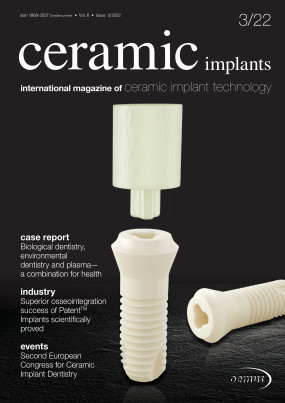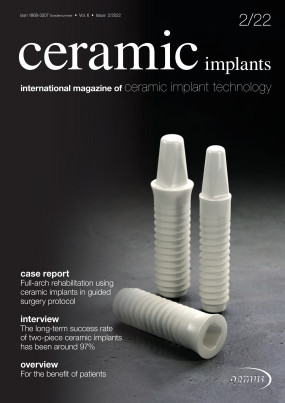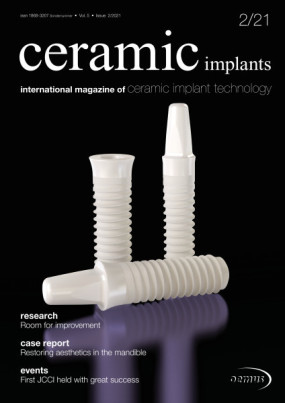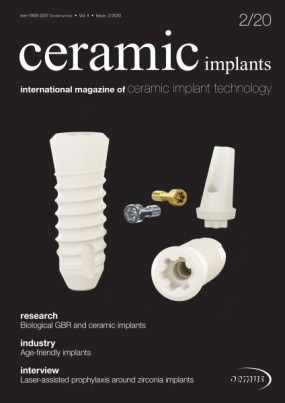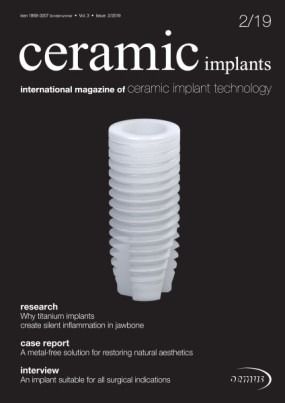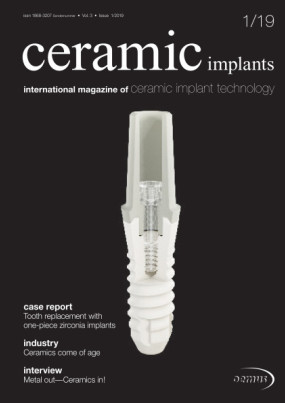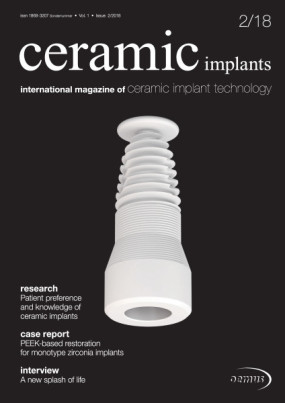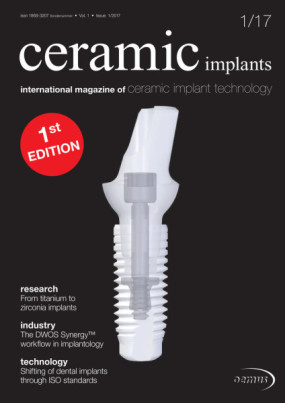Inhaltsverzeichnis
3
Editorial: The future has arrived, and we are art and part of it
Dr Rodrigo Beltrão, Dr Enrique Reinprecht
Oral implantology, whether metallic or ceramic, has undoubtedly had a global impact on the profession and on the daily lives of our patients. In the early days, implants were only placed by a few dentists, trained in specific centres, and for a few patients, who had the means to access the treatment. In recent decades, most educa- tional institutions specialised in oral health offer training, and this is increasing not only the number of dental pro- fessionals who are considering oral implantology as a specialisation but also the number of patients, who have more access than ever to information regarding dental implants and are therefore increasingly requesting metal- free solutions for their long-term well-being...
6
Zirconia in dentistry has historically been known for its strength and biocompatibility characteristics in simple or complex prosthetic rehabilitation. Only in the last decade has it become more widely used in implantology as well. Zirconia is a mixture of composites based on zirconium dioxide. Zirconium is the metal from which the eponymous dioxide is derived...
12
Full-arch rehabilitation using ceramic implants in guided surgery protocol
Dr Alexandr Bortsov, Russia
Patients with metal allergies and heightened allergic status represent a challenge for dental implant treatment. Nowadays, ceramic implants are emerging as a viable solution for such patients, offering the advan- tages of tooth-like colour, enhanced soft-tissue healing and lower affinity to plaque accumulation. However, fast and efficient treatment protocols with ceramic implants are still very demanding, particularly when it comes to full-arch restorations.
16
Immediate implantation with platelet-rich fibrin and immediate loading
Prof. Belir Atalay & Dr Beril Atalay, Turkey
Since Brånemark first described dental implantology many years ago, the waiting time for implantation and loading has changed owing to material and implant surface characteristics. After osseointegration was defined, different implant materials were produced. Today, titanium is the most preferred material, but mixed materials of titanium and zirconia have been developed for dental implantology in addition to titanium, and zirconia implants with metal-free content are availabl...
22
Recent years have seen a continuous increase in the demand for zirconia dental implants as a result of growing public health awareness and a surge in material sensitivity cases. For one thing, zirconia implants elicit little inflammatory reaction from the peri-implant tissue and provide a particularly high degree of epithelial attachment. In addition, zirconia implants have a rather natural appearance owing to their white, almost tooth-like colour, facilitating highly aesthetic treatment outcomes...
26
A goal of implant placement is the provision of an osseointegrated fixture to support an aesthetic and functional restoration.1 Imperative to the success of this treatment modality is ensuring optimal bone between the implant and periapical bone, bone–implant contact at the most coronal level and the least amount of buccal bone and soft-tissue recession or atrophy.1 ...
32
“Patients come to us because they know we focus heavily on their health and well-being”
An interview with Dr Holger Scholz, Germany
Dr Holger Scholz is owner and manager of the Dental Clinic Konstanz private practice in Germany, specialising in metal-free and digital dentistry, and a consultant dentist at the Swiss Mountain Clinic in Castaneda in Switzerland. From the moment he used a metal-free implant made of zirconia, he was enthusiastic about the new possibilities offered by this material and recognised its potential. Dr Scholz deals intensively with holistic health concepts for a sustainably successful life, especially with the connections between nutrition, exercise, mental attitude and success. In the following interview, Dr Scholz talks about his experiences with the new generation of the whiteSKY ceramic implant system (bredent medical)...
34
The long-term success rate of two-piece ceramic implants has been around 97%.
An interview with Dr Elisabeth Jacobi-Gresser, Germany
She was already critically concerned with the material titanium when it was still considered biocompatible and inert. Dr Elisabeth Jacobi-Gresser is a practising oral surgeon specialised in implantology, who is also a founding member of the German Society for Environmental Dentistry (DEGUZ e.V.) and former director of the Integrative Den- tistry curriculum of the Dental Association of Rhineland- Palatinate (Landeszahnärztkammer Rheinland-Pfalz). As a board member of the DGZI, she is engaged to imple- menting ceramic implantology to certified modular education and explains in the following interview with ceramic implants—international magazine of ceramic implant technology, what modern two-piece ceramic implant systems can and must achieve today...
38
Around the world, a strong community of scientically recognised and renowned specialists, of interested and motivated members of dental practices and universities, of strong and quality-oriented company partners, and of professional societies are all committed to one goal: the scientific production and dissemination of evidence-based and well-founded knowledge about dental ceramic im- plants for the benefit of patients. Dental implant treatment with ceramic implants is currently one of the fastest growing, most research-intensive and most innovative areas in dentistry...







